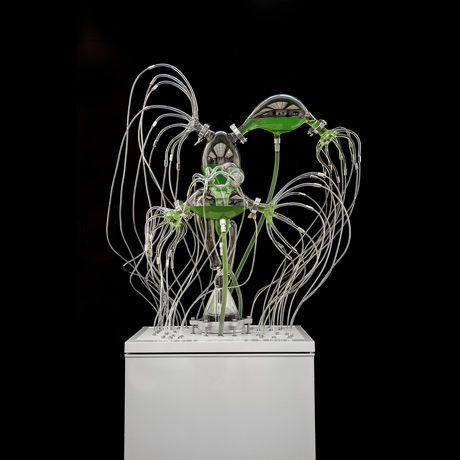
GREEN HYDRA, 2021
Hydras (many-headed Hydra viridissima), green algae (Chlorella vulgaris), glass, plastic, pump technology, refrigerator, 170 × 72 × 57 cm
Thanks to Bert Hobmayer, Institute of Zoology, University of Innsbruck, with the kind support of the Frankfurter Kunstverein
GREEN HYDRA is a mouth-blown glass sculpture in the shape of a many-headed hydra, inside which freshwater polyps (Hydra viridissima) are cultivated. The hydras live in a water-filled chamber of the sculpture and form a symbiotic relationship with Chlorella algae. The chlorophyll of the microalgae glows through their transparent bodies and colors them green. Both creatures complement each other's animal and plant metabolism and use light and plankton as a source of energy and food.
In recent years, symbiotic communities have taken on a metaphorical significance in the debate on new models of society. In her book The Symbiotic Planet (1998), Lynn Margulis transferred biochemical observations to human life forms and interwove these conceptual abstractions across disciplines. She emphasizes the ability of plant life to enter into relationships with their environment through cooperation with other species, so that the life of different species remains in a permanent balance. In this sense, Hydra viridissima embodies an exemplary holobiont.
Hydras (many-headed Hydra viridissima), green algae (Chlorella vulgaris), glass, plastic, pump technology, refrigerator, 170 × 72 × 57 cm
Thanks to Bert Hobmayer, Institute of Zoology, University of Innsbruck, with the kind support of the Frankfurter Kunstverein
GREEN HYDRA is a mouth-blown glass sculpture in the shape of a many-headed hydra, inside which freshwater polyps (Hydra viridissima) are cultivated. The hydras live in a water-filled chamber of the sculpture and form a symbiotic relationship with Chlorella algae. The chlorophyll of the microalgae glows through their transparent bodies and colors them green. Both creatures complement each other's animal and plant metabolism and use light and plankton as a source of energy and food.
In recent years, symbiotic communities have taken on a metaphorical significance in the debate on new models of society. In her book The Symbiotic Planet (1998), Lynn Margulis transferred biochemical observations to human life forms and interwove these conceptual abstractions across disciplines. She emphasizes the ability of plant life to enter into relationships with their environment through cooperation with other species, so that the life of different species remains in a permanent balance. In this sense, Hydra viridissima embodies an exemplary holobiont.